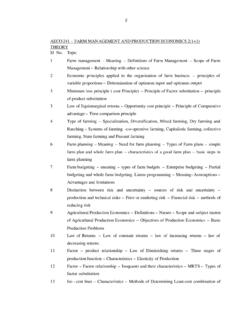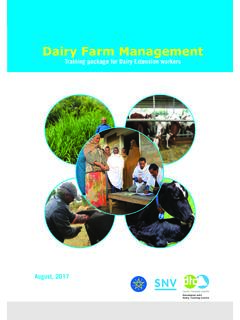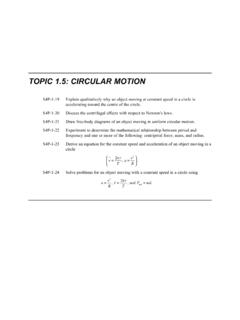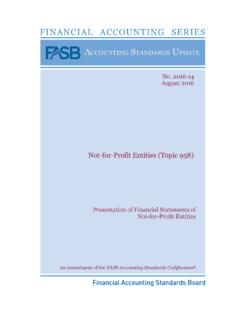Transcription of DESIGN GUIDE FOR ON-FARM DEMONSTRATIONS
1 DESIGN GUIDE FOR ON-FARM DEMONSTRATIONSI ntroduction | 3 IntroductionOn- farm DEMONSTRATIONS have been organised for at least two centuries, originally as a way to introduce farmers to innovation, but more recently also to share experiences in a farmer-to-farmer setting, and to support knowledge co-creation between farmers and other actors. Increasingly, farmers themselves are opening their farms to connect with their peers and the general public as part of business development strategies ( short food supply chains, community supported agriculture). demonstration activities can range from one-off field day events to multi-year monitor farms where farmers, advisors and industry members come together at regular intervals to assess farming opportunities in situ, to perma-nent research farms where researchers test and demon-strate innovative technologies and approaches.
2 ON-FARM DEMONSTRATIONS thus follow a wide range of approaches, are planned with different objectives in mind, and are ini-tiated and organised by a wide range of actors. Given this variety, there is no one-fits-all approach for a successful ON-FARM demonstration event. This GUIDE offers an overview of the most important ele-ments that should be considered when it comes to prepar-ing, carrying out and evaluating ON-FARM DEMONSTRATIONS . It proposes 6 simple steps to follow when designing an ON-FARM demonstration event, starting from a clear defi-nition of the objectives and ending with a good evaluation and follow-up. Throughout, this GUIDE offers concrete tips and tricks and provides specific tools to support the DESIGN of your online version is available at: GUIDE is a result of a strong collaboration between 3 farm -Demo projects that received funding from the European Union s Horizon 2020 research and innovation programme under grant agreements N 727388 (PLAID), N 728061 (Agridemo-F2F), and N 772705 (NEFERTITI).
3 FARMDEMO Demo DESIGN GUIDE | 4 DESIGN YOUR ON-FARM demonstration EVENT IN 6 STEPS1 Demo objectives and target groups- 7-- 11 -- 13 -2 demonstration farm3 Demo set-up State clear objectives Target your farming audience in line with your objectives Invite other actors to increase the impact Select your host farm in line with your objectives Go for a credible and innovative host farmer Ensure access by good location and facilities Compose a balanced organisation team in line with your objectives Provide enough time for interaction and networking Consider trade-offs when selecting a suitable time Compensate the host farmersDesign your ON-FARM demonstration event in 6 steps | 5- 17-- 20 -- 25 -4 Promotion5 Learning and facilitation methods6 Evaluation and follow-up State your key messages in line with your objectives Adapt the jargon to your target audience Go for a clear and appealing invitation Use multiple communication channels Relate learning content to farming practice Engage participants in active knowledge exchange Use a variety of learning methods Split up larger groups Evaluate if your objectives have been met Use and implement the results of your evaluation Organise follow-up activities for both participants and non-participantsDemo objectives and target groups | 7 Demo objectives and target groups What do you want to
4 Achieve with the demo? For any demo event it is important to explicitly state clear objective(s) and key messages well in advance. They determine all the other decisions you will make during the preparation and the performance of the demo event: the set-up, which actors to involve, the evaluation of by addressing the why (why are we doing this demo) and then the what (what do we want to demon-strate). From this demo objective subsequently follows the who (the targeted audience for the demo) and the how (the demo set-up and learning methods).1 FARMDEMO Demo DESIGN GUIDE | 8 Possible targeted effects: Knowledge co-creation. You can aim to create (new) knowledge, by profiting from the knowledge pool of the participants that attend the demo event.
5 Innovation adoption. Demos help the transfer of new opportunities, novelties or practical experience that can be used directly on farms. These innovations can emerge from research, business (related to product sales) or pioneer farmers and give farmers the confi-dence to make a grounded decision on the usefulness of the demonstrated practices or innovations for their own farm . Problem solving. Demos are a useful platform to link extension to the needs of local farmers. You can demonstrate solutions to farmers problems, for example related to reducing farm labour or how to grow crops in a changing climate, or you can validate conducted research and innovations under local con-ditions and tailor them to the farmers needs.
6 Training. Demos serve as a platform for skills enhance-ment and capacity building, thus enabling practical implementation of innovative practices on the farm . Building awareness. Demos can raise awareness on topics like for example social demands. Also, sustaina-bility topics are often not addressed explicitly, but are often part of the demonstration to create awareness with the participants. Networking. Demo events can act as meeting place for participants. Regular ( yearly) demo events can be used as network event to gather all people in-volved in the programme, network or project. They can contribute to the strengthening and development of collaboration and boost possible partnership for cooperative problem solutions, both national and inter-national.
7 Also, the social aspect of networking, being able to meet other farmers, is very attractive to some participants. Research implementation. ON-FARM demo events can act as a platform to transfer knowledge on applied research results to agricultural practice. Innovations and practices can be trialled, compared or validated in real farm conditions. Policy implementation. Demos are an opportunity to inform farmers on new legislation and policy regula-tions and to provide specific practices and examples on how they are able to implement them on their DO YOU WANT TO ORGANISE THE DEMO EVENT?This specifies the motivation or need for the regional agricultural developments and challenges into account to attract farmers and to increase your events can act as meeting place for participantsDemo objectives and target groups | 9 Demo topics can be very diverse, like for example the demonstration of a product, a machine, a process, manage ment or marketing.
8 The characteristics of the topic demonstrated influence the demo set-up and which target groups can potentially be reached. Is it an innovation not at all known by the farming community with no real-life implementation examples? Is it already implemented by a minority of farmers? Is it a widespread practice that could be optimised and refined by farmers? Often the strength of a demo event lies in its simplicity. It is therefore advisable to limit the number of topics ad-dressed during one event. If you want to address multi-ple topics , you may consider organising a series of demo events or make sure sufficient time is planned for each individual topic. WHAT DO YOU WANT TO DEMONSTRATE?
9 Series of demos vs. one-off An important choice in deciding on the set-up of a demo, depends on whether it will be a one-off demo, a series of demos on the same topic, or a reoccurring (network) event organised by the same of demos are sometimes mentioned as being more effective because: Participants get to know and to trust each other (they will be less reluctant to share information). Demos can address several steps in the adoption process (more targeted effects). It allows to show evolution through time, seasonality. You can reach more farmers and multiple stakeholder types. Demos can rely on the good reputation of previous demos. The organisation and set-up can be im- choice of the topic can be made top-down by the organisers, by farmer representatives, or by the project in which the demo is embedded, as well as bottom-up with farmer involvement, or by participants on a previous demo event when it involves a series of demo events.
10 Either way, a thorough consideration or discussion beforehand is necessary to select an interest-ing, inspiring and relevant topic. FARMDEMO Demo DESIGN GUIDE | 10 WHO DO YOU TARGET?The selection of the target group(s) depends on what you aim to achieve with the demo. For example, if intensive knowledge exchange or knowledge co-creation on a very specific topic is envisioned, you might choose to target a small group of farmers who speak a similar language to assure qualitative and intense interactions. Identifying specific target groups will determine which information channels should be used to reach target group can be specified in relation to: Specific sectors ( dairy farmers, sugar beet producers) A specific region ( a specific province, nationwide, or international) Their experience with a specific technique, novice or expert.






